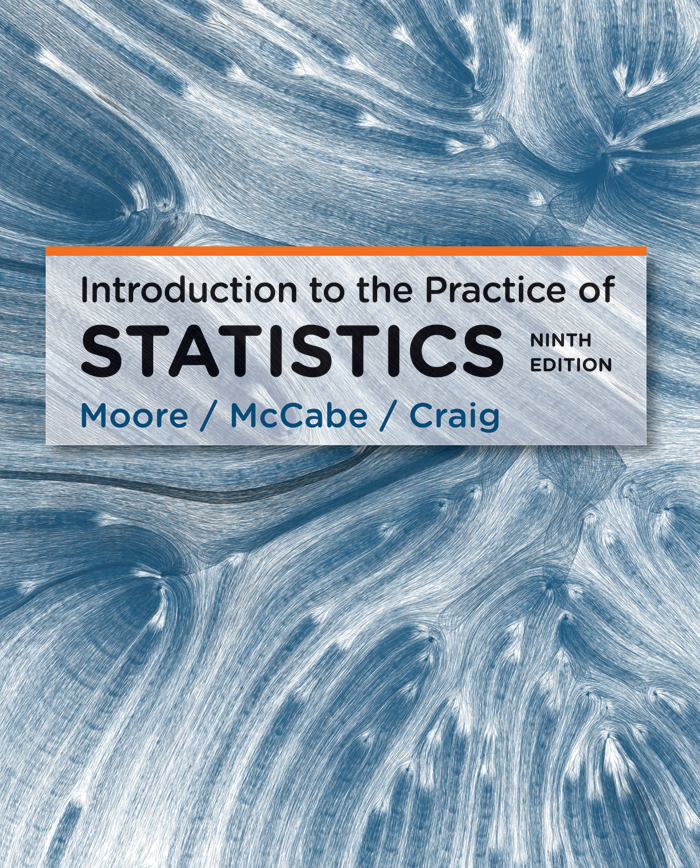Contents

Introduction to the Practice of Statistics
NINTH EDITION

David S. Moore
George P. McCabe
Bruce A. Craig
Purdue University

Vice President, STEM: Ben Roberts
Publisher: Terri Ward
Senior Acquisitions Editor: Karen Carson
Marketing Manager: Tom DeMarco
Marketing Assistant: Cate McCaffery
Development Editor: Jorge Amaral
Senior Media Editor: Catriona Kaplan
Assistant Media Editor: Emily Tenenbaum
Director of Digital Production: Keri deManigold
Senior Media Producer: Alison Lorber
Associate Editor: Victoria Garvey
Editorial Assistant: Katharine Munz
Photo Editor: Cecilia Varas
Photo Researcher: Candice Cheesman
Director of Design, Content Management: Diana Blume
Text and Cover Designer: Blake Logan
Project Editor: Edward Dionne, MPS North America LLC
Illustrations: MPS North America LLC
Production Manager: Susan Wein
Composition: MPS North America LLC
Printing and Binding: LSC Communications
Cover Illustration: Drawing Water: Spring 2011 detail
(Midwest) by David Wicks
Look Back Arrow: NewCorner/Shutterstock
Library of Congress Control Number: 2016946039
Student Edition Hardcover:
ISBN-13: 978-1-319-01338-7
ISBN-10: 1-319-01338-4
Student Edition Loose-leaf:
ISBN-13: 978-1-319-01362-2
ISBN-10: 1-319-01362-7
Instructor Complimentary Copy:
ISBN-13: 978-1-319-01428-5
ISBN-10: 1-319-01428-3
2017, 2014, 2012, 2009 by W. H. Freeman and Company
All rights reserved
Printed in the United States of America
First printing
W. H. Freeman and Company
One New York Plaza
Suite 4500
New York, NY 10004-1562
www.macmillanlearning.com
Brief Contents

To Teachers: About This Book

Statistics is the science of data. Introduction to the Practice of Statistics (IPS) is an introductory text based on this principle. We present methods of basic statistics in a way that emphasizes working with data and mastering statistical reasoning. IPS is elementary in mathematical level but conceptually rich in statistical ideas. After completing a course based on our text, we would like students to be able to think objectively about conclusions drawn from data and use statistical methods in their own work.
In IPS, we combine attention to basic statistical concepts with a comprehensive presentation of the elementary statistical methods that students will find useful in their work. IPS has been successful for several reasons:
- IPS examines the nature of modern statistical practice at a level suitable for beginners. We focus on the production and analysis of data as well as the traditional topics of probability and inference.
- IPS has a logical overall progression, so data production and data analysis are a major focus, while inference is treated as a tool that helps us draw conclusions from data in an appropriate way.
- IPS presents data analysis as more than a collection of techniques for exploring data. We emphasize systematic ways of thinking about data. Simple principles guide the analysis: always plot your data; look for overall patterns and deviations from them; when looking at the overall pattern of a distribution for one variable, consider shape, center, and spread; for relations between two variables, consider form, direction, and strength; always ask whether a relationship between variables is influenced by other variables lurking in the background. We warn students about pitfalls in clear cautionary discussions.
- IPS uses real examples to drive the exposition. Students learn the technique of least-squares regression and how to interpret the regression slope. But they also learn the conceptual ties between regression and correlation and the importance of looking for influential observations.
- IPS is aware of current developments both in statistical science and in teaching statistics. Brief, optional Beyond the Basics sections give quick overviews of topics such as density estimation, scatterplot smoothers, data mining, nonlinear regression, and meta-analysis. Chapter 16 gives an elementary introduction to the bootstrap and other computer-intensive statistical methods.
The title of the book expresses our intent to introduce readers to statistics as it is used in practice. Statistics in practice is concerned with drawing conclusions from data. We focus on problem solving rather than on methods that may be useful in specific settings.
GAISE The College Report of the Guidelines for Assessment and Instruction in Statistics Education (GAISE) Project (www.amstat.org/education/gaise/) was funded by the American Statistical Association to make recommendations for how introductory statistics courses should be taught. This report and its update contain many interesting teaching suggestions, and we strongly recommend that you read it. The philosophy and approach of IPS closely reflect the GAISE recommendations. Lets examine each of the latest recommendations in the context of IPS.
- Teach statistical thinking. Through our experiences as applied statisticians, we are very familiar with the components that are needed for the appropriate use of statistical methods. We focus on formulating questions, collecting and finding data, evaluating the quality of data, exploring the relationships among variables, performing statistical analyses, and drawing conclusions. In examples and exercises throughout the text, we emphasize putting the analysis in the proper context and translating numerical and graphical summaries into conclusions.
- Focus on conceptual understanding. With the software available today, it is very easy for almost anyone to apply a wide variety of statistical procedures, both simple and complex, to a set of data. Without a firm grasp of the concepts, such applications are frequently meaningless. By using the methods that we present on real sets of data, we believe that students will gain an excellent understanding of these concepts. Our emphasis is on the input (questions of interest, collecting or finding data, examining data) and the output (conclusions) for a statistical analysis. Formulas are given only where they will provide some insight into concepts.
- Integrate real data with a context and a purpose. Many of the examples and exercises in IPS include data that we have obtained from collaborators or consulting clients. Other data sets have come from research related to these activities. We have also used the Internet as a data source, particularly for data related to social media and other topics of interest to undergraduates. Our emphasis on real data, rather than artificial data chosen to illustrate a calculation, serves to motivate students and help them see the usefulness of statistics in everyday life. We also frequently encounter interesting statistical issues that we explore. These include outliers and nonlinear relationships. All data sets are available from the text website.












